- Mar 3, 2023
Kayak Fishing Tips for Late Winter Bass in Rivers
Small rivers provide good early-season bass fishing opportunities, but they can be tricky at times. These tips from a kayak fishing specialist will help you find early season bass fishing success.
As day length increases, the typical angler’s desire to spend time on the water also increases. Endless late-winter fronts make spring-like fishing conditions slow to arrive, though, and lingering cold water can make bass fishing challenging.
Smaller rivers provide good early season bass fishing opportunities, and the fishing can “heat up” faster than on larger waters. These tips can help you fish smaller rivers effectively this time of year.
Know Your Fishing Location
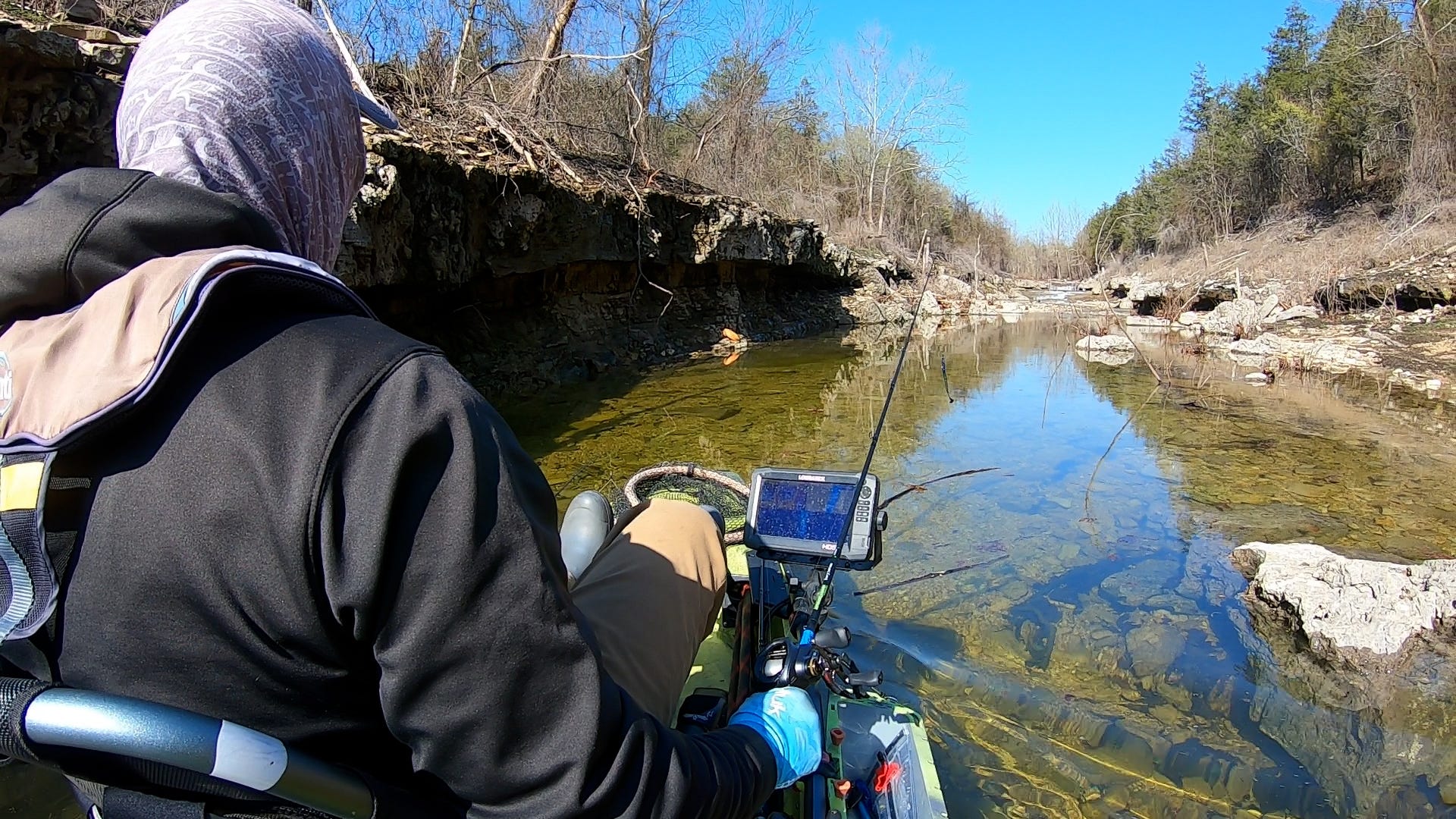

When fishing a river in late winter, choosing the right location is essential, and that begins with knowing the river or creek you are fishing. Wintertime is not the best time to go into unfamiliar situations. Often during later winter, creeks and rivers can be a bit low unless there have been recent rains or snow melt. If the river is high or has much runoff, be sure you can navigate it safely before planning a fishing outing.
It's also important to understand what type of bass live in that river. This matters because locations of bass and the techniques that will work best can vary depending on if you are chasing largemouth, smallmouth or spotted bass. Largemouth are likely more lethargic and often reside in backwater sloughs and deeper pools. Smallmouth bass can thrive in clear cold water near the current and are great to target with the smaller, bottom-oriented baits. Spotted bass are usually the most aggressive and will chase baits, often even in colder water.
Also consider the water color and visibility. When the water temperature is already very low (high 30s to mid-40s), an extremely dirty or muddy river is almost impossible to fish. At the opposite end of the spectrum, if the water is crystal clear and you can see the bottom almost everywhere, you probably won’t get many bites. I prefer to find a river with just a bit of color, enough to obscure visibility, but relatively clean overall.
Pay Attention to Weather Patterns
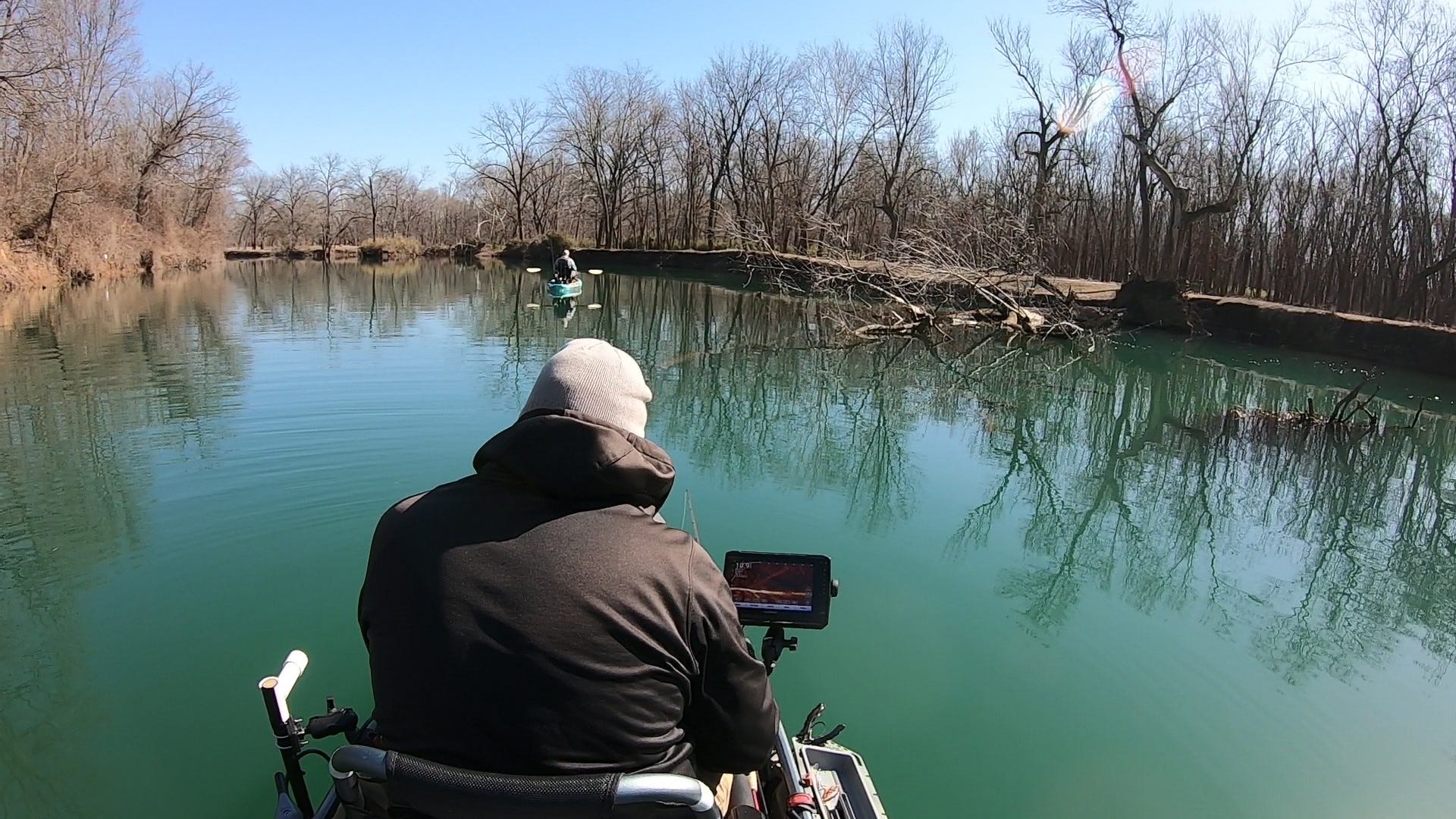

Bass in rivers and creeks are not immune to the effects weather patterns. High and low-pressure influences, as well as warm and cold fronts, can influence bass activity.
When the weather has been consistently cold or there’s cold-water runoff, the bass may congregate in deeper pools with less current and won’t move much that day, making the fishing challenging. On a suddenly warm and sunny day, bass will get the urge to find a bit shallower, warmer water, especially along sunny, rocky banks, which will warm up quicker.
If there has been a recent rain, particularly if the air temperature is significantly warmer than the water temperature, bass will move to areas where warmer, fresh water enters the river. This brings warmth and food, so look for ditches, secondary creek beds, and intersections of water sources.
However, heavy rain events will become more common as we get closer to spring. Too much rain at once can make fishing difficult and create a dangerous situation if the water is too high or there is too much current to navigate safely. Be aware of the water conditions after heavy rain in spring to ensure a safe and successful trip.
Slow Your Presentations
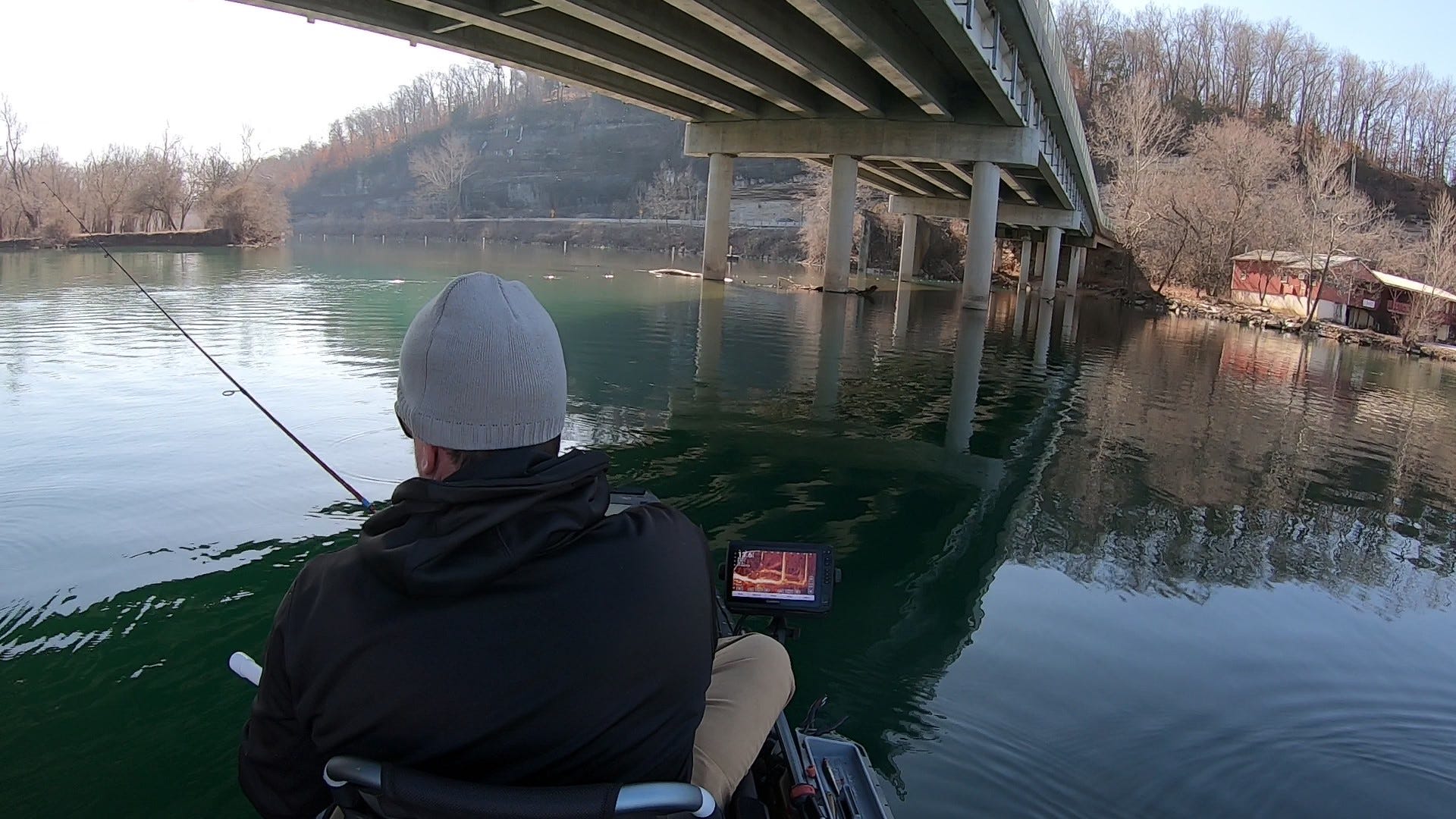

When water gets frigid during winter, fish tend to move more slowly and feed less often. Work your bait more slowly. The tougher the bite, the more patient you need to be. If fishing a bottom bait, give it time to sink and work it slowly, or even let it sit a bit. These fish are lethargic and don’t want to work hard for a meal. Make it slow and easy.
One of the most important things to know is that if you catch a bass in an area, work that area thoroughly. During winter bass group up in small areas – so if you find one, there are more to catch.
If you are fishing a moving bait like an umbrella rig, small swimbait, spinnerbait, or small crankbait, it is best to work it very slowly, often rubbing or bumping the bottom, and moving just fast enough for the bait to have the appropriate action. Around the cover, you want to slowly “worm” it through the cover, slowly working it in and around and over where fish may be hiding.
Depending on where you are in the country, things may start to warm up by early March, and the fish may become more active. Adjust accordingly as the water temperature rises above 45, and you can move your baits along quicker and get bit. If the bite is tough, as the water warms closer to 50, it’s a great time to toss a weightless YUM Dinger around and fish it slowly.
Dress & Prepare for Safety
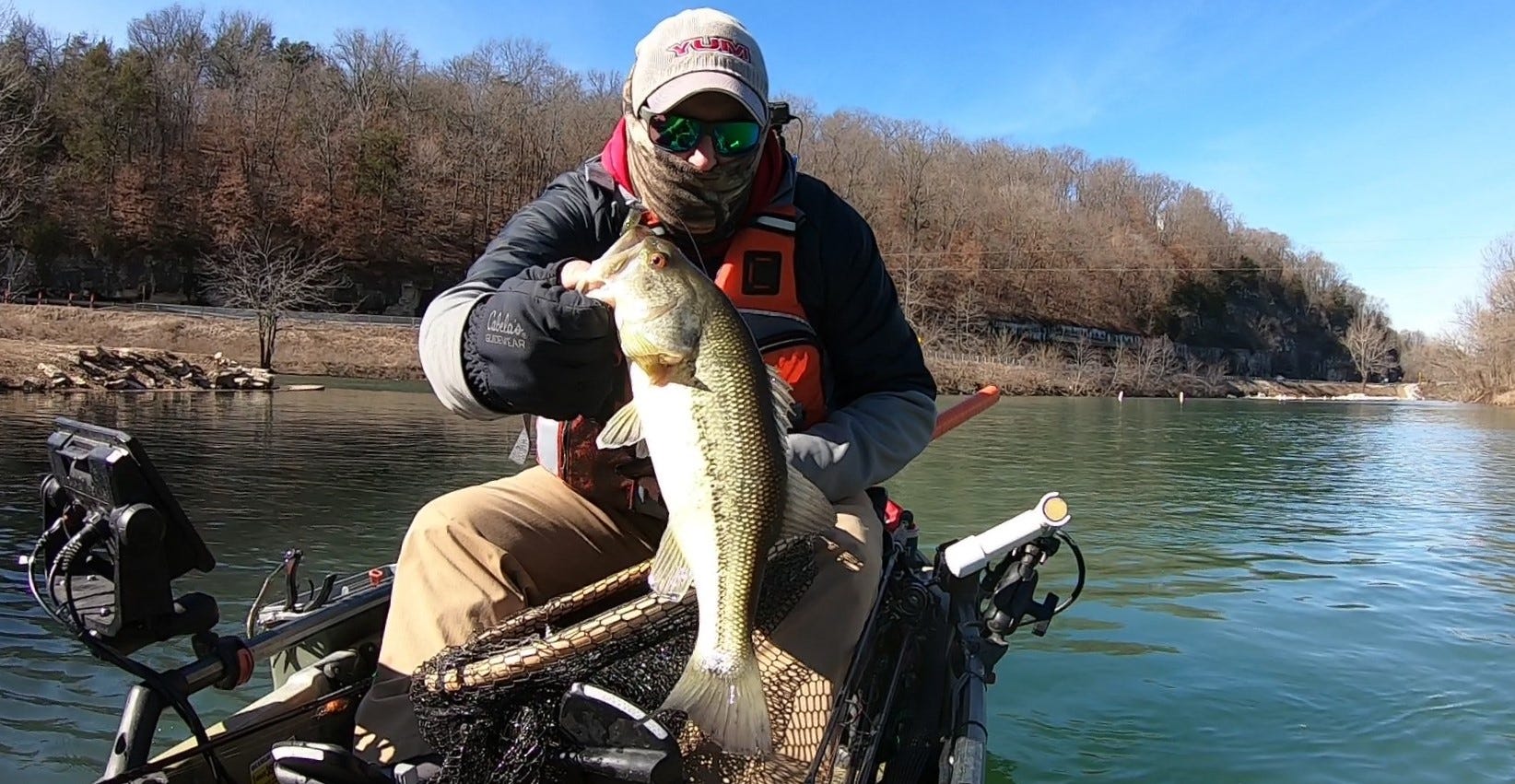

Fishing in cold weather can be an enjoyable experience if you have suitable protective clothing. Wearing warm, layered clothing is critical, and if you plan on wading, ensure you have on insulated waders or boots. Getting wet on a cold day can quickly get an angler in trouble. A hat and gloves also make a big difference in keeping your head and hands warm.
The water temperature can also affect your personal floatation device choice. For most of the year, I’ll wear an inflatable PFD. I prefer a traditional non-inflatable PFD in cold water situations because they are more reliable and safer in water below 50 degrees.
If you are making a float trip, carry extra supplies for safety. Take extra dry clothing, including a base layer, in case you unexpectedly wind up in the water. A lightweight emergency blanket, easy fire starter, and first aid kit are all good additions to your gear.
If you are going alone, be sure someone knows where you’ll be fishing and when to expect you to return.
Enjoy the Trip
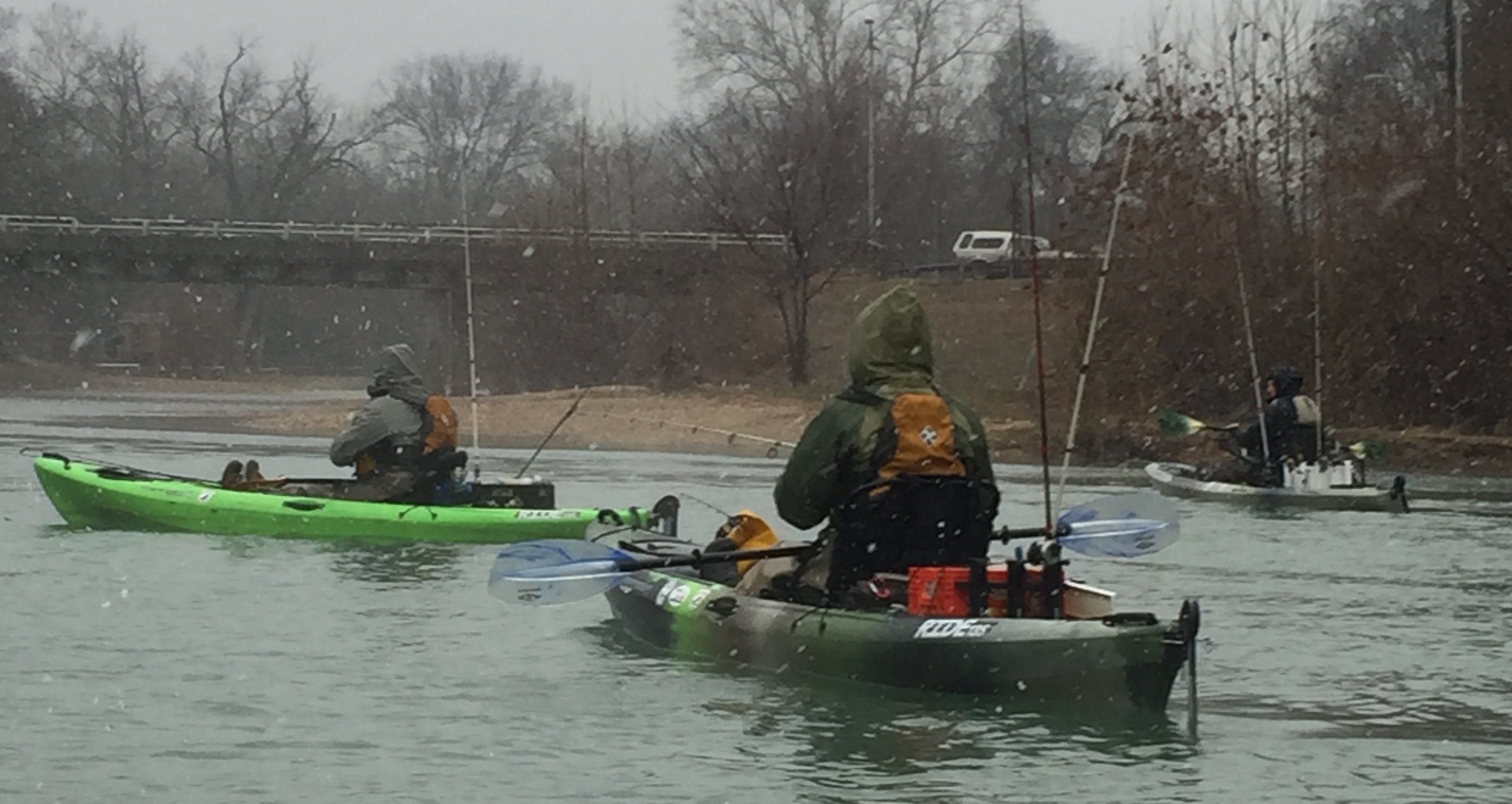

Fishing in late winter can be challenging, but it also can be gratifying. Some of the largest bass I’ve caught have been from late winter to early spring. It is sometimes easier said than done but try to be patient, and it can pay off. Give your bait time to work. Eventually, you can find where the bass are congregated that day. When you locate the fish and find the right bait, it can be a fantastic day of fishing.
You don’t have to wait for high temperatures to get out and catch some bass. Use these tips and go on a small river or creek fishing trip this weekend.
Top 5 Bass Baits for Late Winter & Early Spring
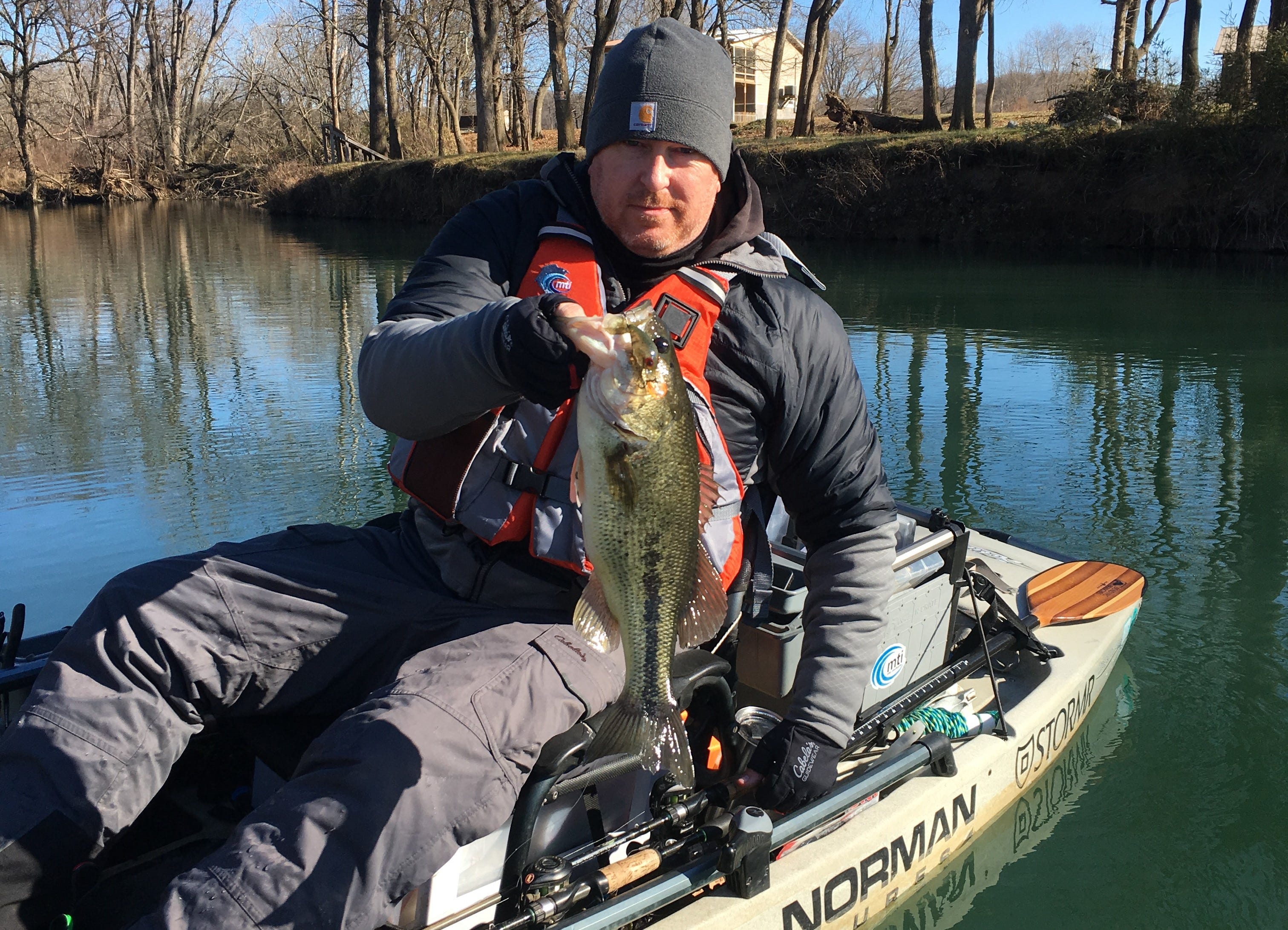

Many baits can be effective in cold weather, but let’s focus on the ones we’d use most often in small, skinny water situations. In general, we’re going to downsize in wintertime. A great place to start for small rivers and creeks is the Bait School Bank & Creek Kit, with baits explicitly designed for this style of fishing. With this kit, you know you have a selection of baits that will catch fish in skinny water.
As for individual baits to use in these small water winter fishing situations, I do have some favorites.
- Small plastics like the 3-inch YUM Scottsboro Swimbait or Ribbontail Grub on a lightweight jig head are among of the most reliable options and are easy to fish from a kayak. Slow roll just enough to get the tail to move, or “scrub” it along the bottom as slowly as possible.
- Another small plastic bait that catches them in winter is a ned style jighead with a YUM Ned Dinger. This bait can be thrown anywhere in a river or creek and is easy to yo-yo, swim, or dead stick on the bottom. An underrated use of the YUM Ned Dinger is to Texas rig it with a 1/10- or 1/8-unce weight.
- Some hard baits will play in the right situations. A little larger body of water with deeper areas or around bridge pilings can be a great place to fish a jerk bait like a Super Rogue Jr to generate a reaction bite from bass grouped together.
- An area with chunk rock, laydowns, or submerged trees and stumps can be effectively fished with a small crankbait and “worming” it slowly across and into cover to generate a strike.
- If you can find an area where bass are stacked up on a channel swing, bridge, or drop-off, a YUM Flash Mob Jr. with small jig heads and 3-inch swimbaits can really catch ‘em!



